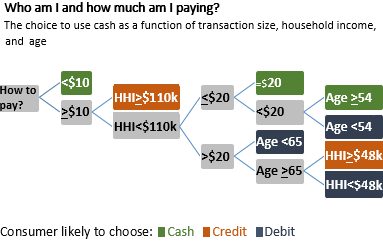FADE IN:
INTERIOR, VETERINARY HOSPITAL—LATE NIGHT (2019)
Male, 60ish baby boomer, in work clothes and yellow reflective vest approaches the desk.
"Picking up a prescription.'
"That's $15.17," says the receptionist.
Waiting puppy owner—off-the-clock Payments Risk Expert—slouched in plastic chair, swings around to face desk. She stares rapt at boomer in work clothes.
A moment's pause.
Boomer rummages deep in his right pants pocket, then the left. Crumpled bills appear in his fist. A dime, a nickel, and 2 pennies fall to the counter.
Payments Risk Expert leans back, satisfied, and smiles.
FADE OUT.
That was Yours Truly at the vet last month. Research based on data from the Diary of Consumer Payment Choice predicts that anonymous pet owner would be likely to choose cash and, in the moment, he did.
Oz Shy, senior policy adviser and economist at the Atlanta Fed, applied machine learning algorithms to examine some 17,000 in-person payments from the 2017 and 2018 Diary of Consumer Payment Choice. The decision tree that resulted (below) predicted the likely behavior of my boomer.

Reading from left to right, you can see that the first fork occurs for payments above and below $10. For payments less than $10, U.S. consumers are most likely to choose cash (choices to use cash are represented by the green boxes).
The second fork, for payments of $10 or more, is determined by household income. For payments of $10 or more, people with household income greater than $110,000 are most likely to use a credit card (orange boxes show the choice to use a credit card).
The next fork again occurs for transaction value. For payments equal to $20, it's probable that consumers will choose cash. (In his paper , Oz relates this choice to the denomination typically available from ATM withdrawals.)
Now age comes into play: For payments less than $20 (remember, $15.17), consumers 54 and older (boomers) choose cash.
Voila! The pet-owning baby boomer plays to type.
Oz's research illustrates the importance of transaction value for payment instrument choice. For in-person payments of less than $10, consumers—whatever their household income or demographics—are most probably going to use cash. And for larger transaction values, the decision tree also shows that income and age matter for the choice to use (or not use) cash and other payment instruments.
You can read the paper, "How Currency Denomination and the ATM Affect the Way We Pay," here .



 By Claire Greene, a payments risk expert in the
By Claire Greene, a payments risk expert in the